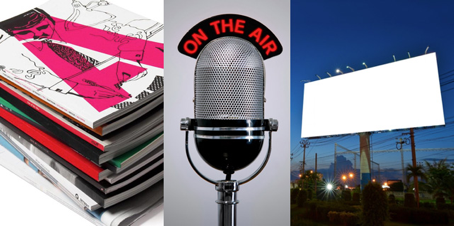With the advent of digital media, new forms of advertising are constantly bombarding people online; on laptops, tablets, even on smartphones. This modern trend is certainly affecting the age-old art of advertising, and lately, many clients rightfully believe that the most effective way to reach their audience is digitally.
This begs the question: is traditional media falling by the wayside?
Traditional media typically includes broadcast, print and outdoor. While the lines between digital and traditional are becoming more and more blurred, traditional media, in its most basic form, is very much still part of the advertising world.
As with any form of advertising, traditional media is best used as part of a strategic media mix, which would likely include digital media. The “low hanging fruit” are typically related to optimizing organic search, well-targeted paid search and, in some cases, a broader campaign that includes social and outbound digital. But, in order to be most successful, and to reach the most qualified audience, advertising should run the full spectrum of digital and traditional media. Digital media is typically placed by using algorithms derived from consumers past behavior. Therefore, when used alone, it can be so focused that potential consumers may miss out on the message completely. At what point is digital marketing so well targeted that it is excluding a portion of people that are still valuable?
Although most online executions are quite targetable, people have also become weary of how they are being targeted digitally. Fish’s media director, Don Skramovsky asserts, “We’ve witnessed some interesting things with the ‘digital boom’. Not only are there late adopters or those who avoid digital entirely, but you also see people ‘unplugging’, a term that didn’t exist until recently. Even after adapting to the new digital environment, many people don’t like how their data is being mined and how they are being observed.” This is one instance where traditional media can fundamentally offer a unique advantage that digital media can’t, by offering a creative environment to observe without requiring two-way interaction and data mining. “Great messaging persuades the audience, and can speak to people who aren’t in your consideration set. That’s what great advertising does, that’s what we do, and I love it!” adds Skramovsky.
So how can we tell if traditional advertising still works? It is inherently more difficult to measure results because it is not interactive. In fact, many clients and agencies have become quite taken with digital analytics, after all, they offer a unique way to monitor and measure interaction. However, in a recent campaign, a Fish client needed to reach a large audience and increase awareness. After some in depth research and planning, Fish took this information and recommended a high percentage of the budget be allocated to traditional advertising. The campaign results were phenomenal, resulting in a significant increase in awareness just months after the campaign launch.
While algorithms for digital advertising can be extremely precise, human behavior isn’t always so easily defined. So yes, as digital advertising is increasingly able to single out target audiences, traditional media is still the vehicle of choice for reaching the masses. With a holistically relatable message, you can turn the tide, start a trend and become a household name.

